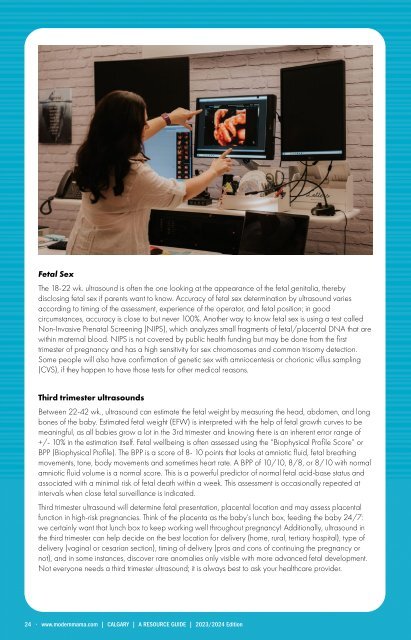Calgary Baby Guide 2023-2024
Create successful ePaper yourself
Turn your PDF publications into a flip-book with our unique Google optimized e-Paper software.
Fetal Sex<br />
The 18-22 wk. ultrasound is often the one looking at the appearance of the fetal genitalia, thereby<br />
disclosing fetal sex if parents want to know. Accuracy of fetal sex determination by ultrasound varies<br />
according to timing of the assessment, experience of the operator, and fetal position; in good<br />
circumstances, accuracy is close to but never 100%. Another way to know fetal sex is using a test called<br />
Non-Invasive Prenatal Screening (NIPS), which analyzes small fragments of fetal/placental DNA that are<br />
within maternal blood. NIPS is not covered by public health funding but may be done from the first<br />
trimester of pregnancy and has a high sensitivity for sex chromosomes and common trisomy detection.<br />
Some people will also have confirmation of genetic sex with amniocentesis or chorionic villus sampling<br />
(CVS), if they happen to have those tests for other medical reasons.<br />
Third trimester ultrasounds<br />
Between 22-42 wk., ultrasound can estimate the fetal weight by measuring the head, abdomen, and long<br />
bones of the baby. Estimated fetal weight (EFW) is interpreted with the help of fetal growth curves to be<br />
meaningful, as all babies grow a lot in the 3rd trimester and knowing there is an inherent error range of<br />
+/- 10% in the estimation itself. Fetal wellbeing is often assessed using the “Biophysical Profile Score” or<br />
BPP (Biophysical Profile). The BPP is a score of 8- 10 points that looks at amniotic fluid, fetal breathing<br />
movements, tone, body movements and sometimes heart rate. A BPP of 10/10, 8/8, or 8/10 with normal<br />
amniotic fluid volume is a normal score. This is a powerful predictor of normal fetal acid-base status and<br />
associated with a minimal risk of fetal death within a week. This assessment is occasionally repeated at<br />
intervals when close fetal surveillance is indicated.<br />
Third trimester ultrasound will determine fetal presentation, placental location and may assess placental<br />
function in high-risk pregnancies. Think of the placenta as the baby’s lunch box, feeding the baby 24/7:<br />
we certainly want that lunch box to keep working well throughout pregnancy! Additionally, ultrasound in<br />
the third trimester can help decide on the best location for delivery (home, rural, tertiary hospital), type of<br />
delivery (vaginal or cesarian section), timing of delivery (pros and cons of continuing the pregnancy or<br />
not), and in some instances, discover rare anomalies only visible with more advanced fetal development.<br />
Not everyone needs a third trimester ultrasound; it is always best to ask your healthcare provider.<br />
24 • www.modernmama.com | CALGARY | A RESOURCE GUIDE | <strong>2023</strong>/<strong>2024</strong> Edition










